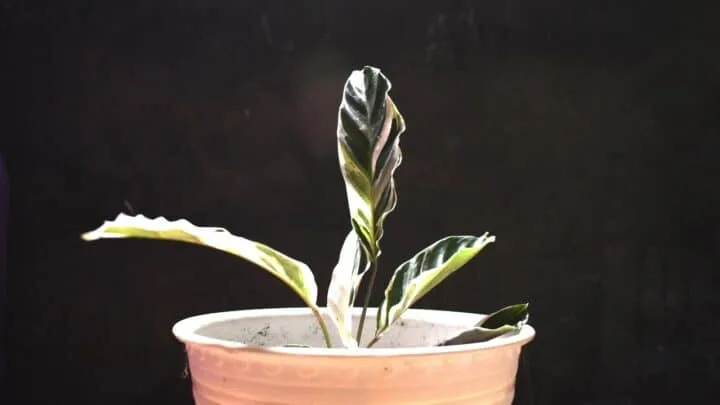Calathea White Fusion is a magnificent and highly valued house plant for its incredible coloring: large glossy leaves have white stripes and edges and a delicate purple underside.
No wonder it is popularly known as a ‘peacock plant.”
This Calathea is considered a queen of “prayer plants”, plants from the family Marantaceae, but also a bit of a drama queen.
Calathea White Fusion is not too difficult to care for, but it tends to be a bit finicky.
If you do not give it the desired humidity and overdo it or underdo it with watering, she is going to show you the errors of your ways.
If you find the right spot in your home for Calathea White Fusion, it will be the showpiece of your indoor plant collection.
Calathea White Fusion and other Marantaceae plants got the nickname “prayer plants” for their habit of folding at night, like getting ready for prayer.
Calathea White Fusion Care
To care for Calathea White Fusion use a well-draining potting mix consisting of peat moss, perlite, and potting soil and water once the top 2” of soil are almost dry (5cm). Provide bright indirect light and a temperature within 65-80°F (18-27°C) as well as a humidity >60%. Fertilize once a month in spring and summer using a balanced fertilizer with NPK 10-10-10 or 5-5-5.
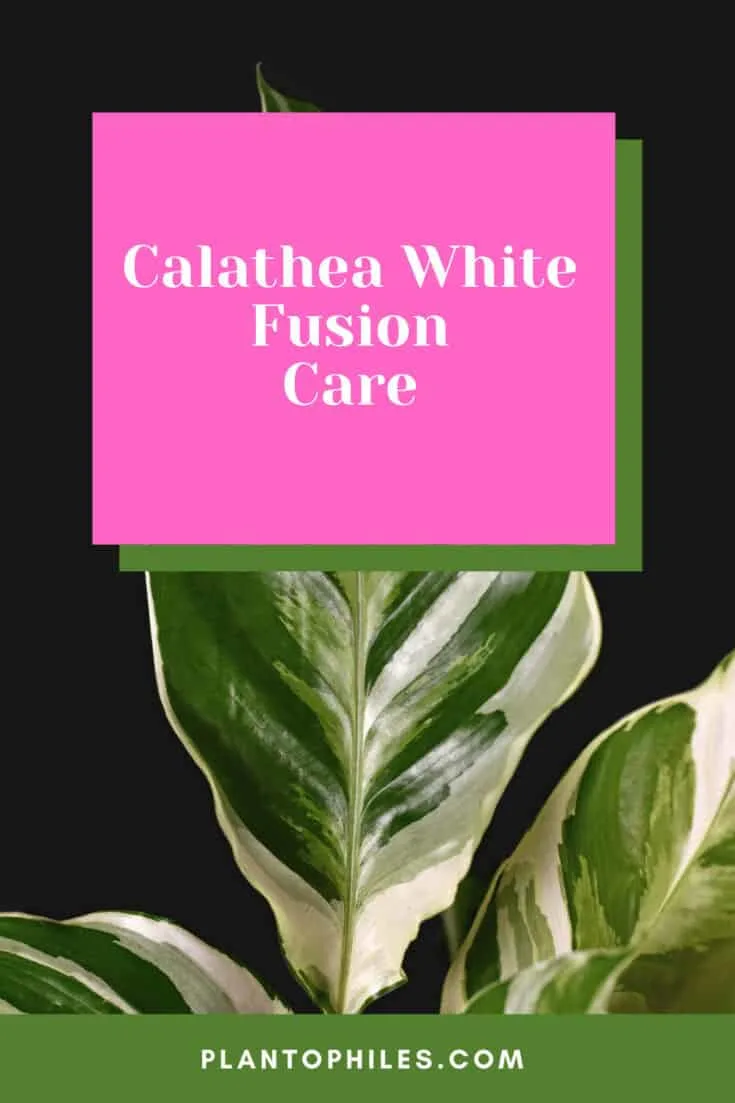
Calathea White Fusion Care
Calathea White Fusion Care Guide
Soil
For Calathea White Fusion use a well-draining potting mix for African Violets or mix your own using peat moss, perlite, and potting soil.
Like with other house plants, the key to providing just the right amount of water is in planting your Calathea in the right soil mix.
Calathea White Fusion is happy in the commercial soil mix for African violets – it is sufficiently peaty to retain enough moisture but also perfectly free-draining to make sure the roots are not drenched in water and rotting.
You can also make your own potting mix.
You will find that, with some variations, it works for most house plants.
Watering
Calathea White Fusion once the top 2” of soil (5cm) are almost dry to the touch.
The Calathea White Fusion likes to grow in consistently moist soil, but if the soil gets soggy, you are going to have problems with root rot.
The simple rule for knowing whether to water your Calathea or not is to stick your finger in the soil.
If the first inch of the soil is dry, it is time to give it a thorough watering. It is crucial that the excess water comes out of the hole in the bottom of the pot.
If your Calathea’s soil is still moist when you touch it, wait for a few days and then check again. In time, you will become an expert in knowing exactly when to water your finicky baby.
Calathea is sensitive to fluoride, which is often added to tap water.
To avoid fluoride toxicity, water your “White Fusion” with rain, filtered, or bottled water.
If you are trying to keep the costs down, fill the bucket with tap water and leave it overnight for the gas to disperse.
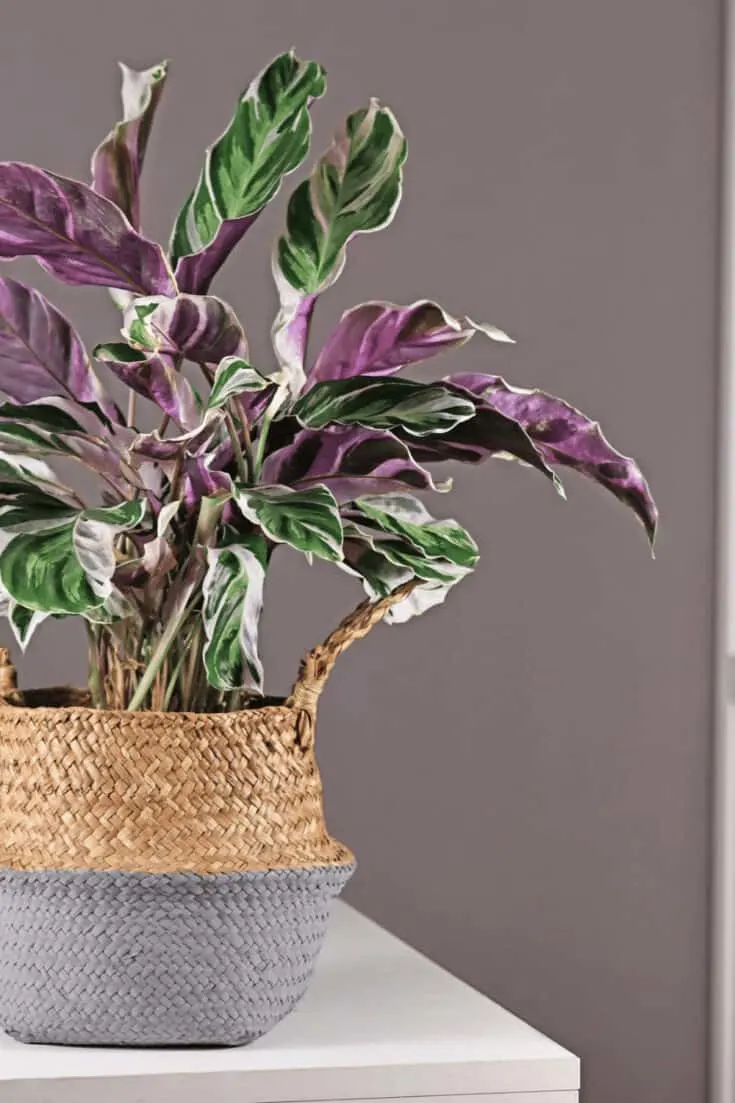
Calathea White Fusion prefers slightly moist soil
Light
Provide bright indirect light for a Calathea White Fusion.
The native home of Calatheas is tropical jungle, where they only get diffused light through the tree canopy.
To mimic that, provide your Calathea White Fusion with filtered bright light.
Avoid south-facing windows, which commonly give too much sunlight. Never put the pot in full sunlight.
Your Calathea will quickly show you if you are not giving it proper light: if it has too much light, its gorgeous markings will start to fade and its leaves will curl; if it does not get enough light, it will stop growing vigorously and its variegated leaves will not develop as they should.
One way to protect your Calathea from too much light is to use a sheer curtain.
Temperature
Calathea White Fusion likes the consistently warm location. Keep the temperature between 65 and 80°F (18 to 27°C).
Never place your Calathea near the heating source, air conditioner, or a draft.
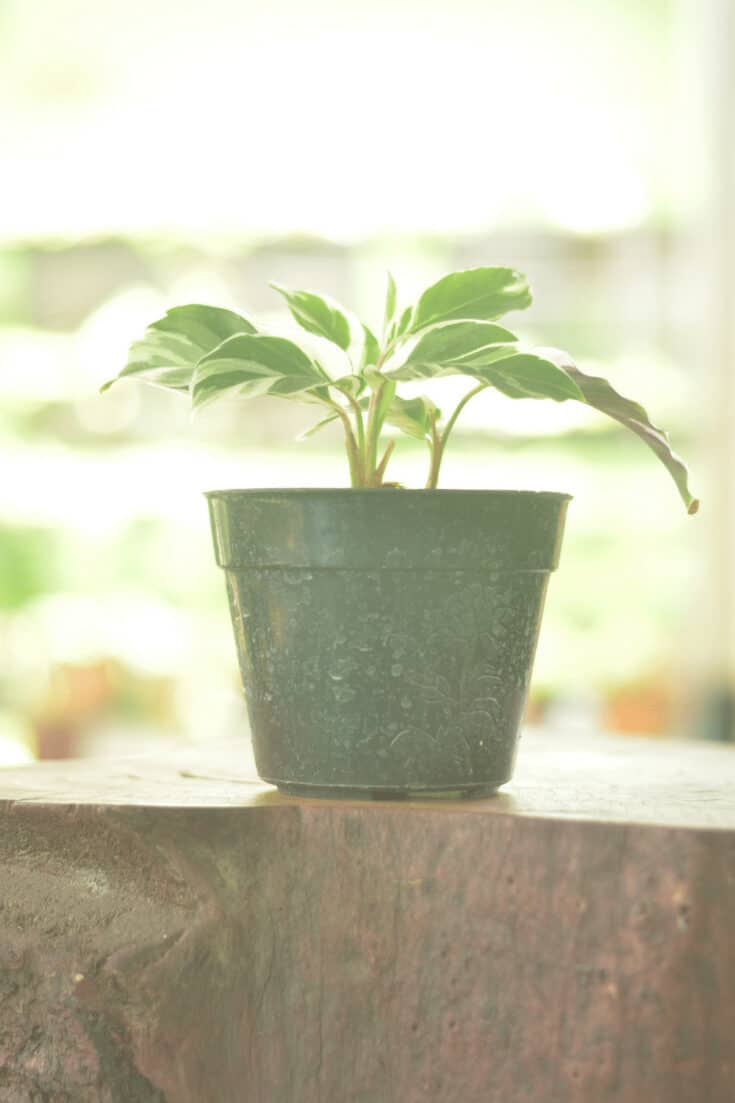
The ideal temperature range for Calathea White Fusion is 65-80°F (18-27°C)
Humidity
Like proper watering, high humidity is a key to having a happy Calathea White Fusion. A humidity of 85% or more is highly desirable. and a humidity of 60% or more necessary.
You can use a humidifier. If you do, your plant will love it.
You can place the Calathea pot on a tray of pebbles filled with water.
You can place it on the bathroom window, as long as it does not get sprayed with hot water. It will enjoy humid steam.
If you have more than one Calathea White Fusion and your bathroom has enough light, definitively keep one in it to give it the touch of glamour.
One easy way to give your Calathea sufficient humidity is to place it together with other humidity-loving plants.
They will create their own micro-climate. Make sure they all have enough space to allow for good air circulation. Pests love humid, stagnant air.
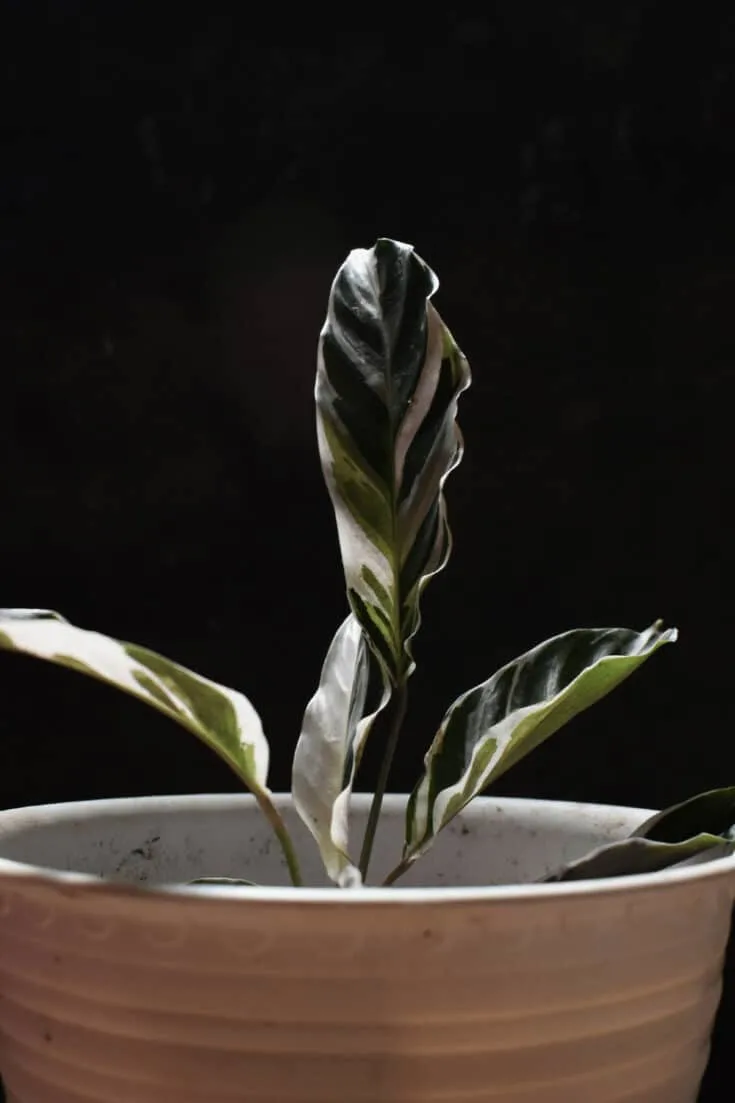
Calathea White Fusion thrives in high humidity above 60%
Fertilizer
During its active growing period, from spring to fall, Calathea White Fusion will enjoy feeding with a balanced liquid house plant fertilizer such as NPK 10-10-10, diluted in half once a month.
You might prefer organic fertilizer. Some commercial products are available, but you can make your own very easily.
Fill half a bucket with rich compost and top it off with water.
Leave this mix for a few days, strain, and dilute the resulting “tea” in half. Compost “tea” is a popular DIY organic fertilizer and once you start making it, you will use it on all your plants.
If you add rich compost to the soil before using it to plant your Calathea, you will not any additional fertilizer until the repotting time.
Stop fertilizing your Calathea White Fusion in winter when its growth slows down.
Never fertilize your plant right after repotting.
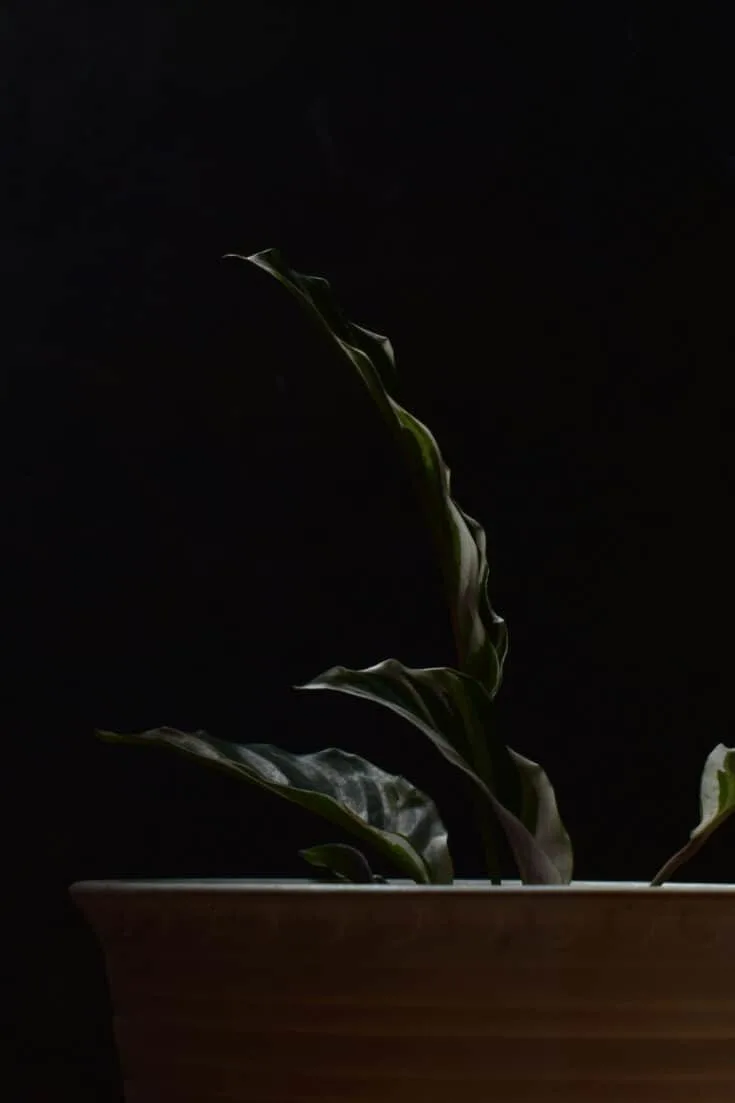
Fertilize Calathea White Fusion once a month in spring and summer with a balanced fertilizer
Repotting
Calatheas are not fast growers and in most cases, they will not need repotting more often once a year or a year and a half.
Repot your Calathea White Fusion in the pot one size bigger than the existing one.
If you prefer your plant not to grow too big, repot it in the same pot it was in. Replace the soil with the fresh one and water your plant thoroughly.
If you are new to repotting, you might appreciate step-by-step repotting instructions.
The best time for repotting is in spring and summer when the plant is growing vigorously.
Pruning
Pruning of a Calathea White Fusion consists of removing damaged, curled, or browned leaves.
Cut a bad leaf at the stem. Do not worry if you have to cut off more than one. The new leaves will grow in their place fairly quickly.
Propagation
If your Calathea White Fusion has grown big enough, it will produce fairly large clumps on its sides. These clumps can be separated and grown as new plants.
The best time to divide your Calathea into more than one is at the time of repotting, in spring or summer, when it is growing vigorously.
Water your plant a few days before repotting it. Remove it gently from the pot.
Once you remove the old soil, gently divide your plant at the natural separations in the roots.
Calathea White Fusion has fragile roots. Be gentle to avoid damaging them.
Plant your new plants in new pots, adding the same type of soil mix you used originally.
Keep them warm and moist and provide them with as much humidity as possible.
Place them at the spot with reduced light for a few weeks, until you see the new growth.
There is a price to the Calathea division – you will lose the lush, dense plant you worked on for so long and will get a few skinny, scrawny-looking youngsters.
But, if you give them the same care and love you gave to their parent plant, you will have a whole bunch of new Calatheas for your collection or wonderful gifts.
Blooms
While many Calatheas bloom in their natural environment and produce magnificent flowers, Calathea grown indoors very rarely blooms.
If your Calathea White Fusion produces a flower, you are doing a truly spectacular job at taking care of it.
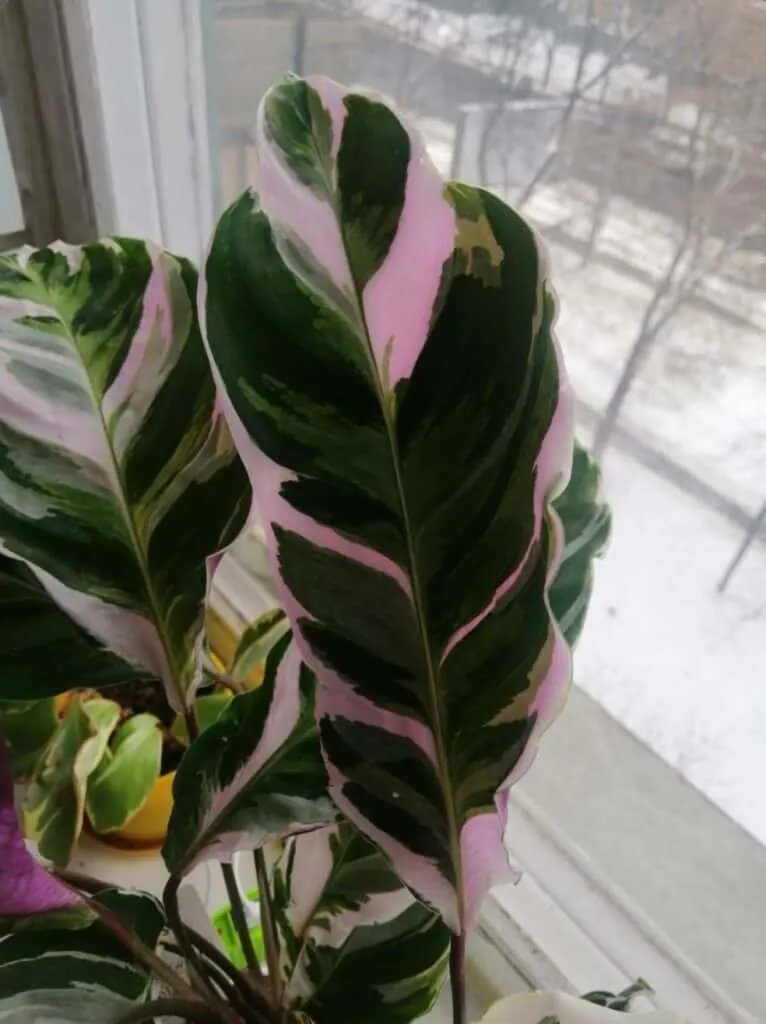
Calathea White Fusion Care – Photo Credit goes to sheep.pillow on Instagram!
Common Problems
Since proper watering is so crucial for the health of Calathea White Fusion, it is no surprise that root rot is its biggest threat.
Root rot
You can avoid root rot by planting your Calathea in well-draining soil and making sure you never overwater it. Do not water your plant until the top inch of the soil is dry.
When choosing a pot for your Calathea, make sure it has a drainage hole at the bottom.
If you are using a cache-pot for decorative reasons, remove the plant from it when watering and replace it only after the excess water has drained out.
If your plant does suffer from root rot, take it out of the pot, remove old soil and cut all damaged parts of roots, leaves, or stems.
Replant your Calathea in the fresh soil and hope that enough healthy roots remained.
Leaf curling or crisping
If the leaves of your Calathea are curling or crisping, you are not providing it with enough water or the humidity is not high enough.
Leaves might curl from too much light as well – your poor plant might try to preserve its moisture.
Crisping of the leaves may occur from chemicals in the water. It is better to use distilled, filtered, or rainwater.
Fortunately, your plant will recover from leaf curling or crisping if you correct its deficiencies. Remove the damaged leaves and the new ones will grow in their place.
Tips for growing Calathea White Fusion
- Give your Calathea White Fusion indirect filtered light to enjoy its magnificent coloring;
- Water your plant only when the top inch of the soil is dry;
- Use peaty, light, free-draining soil;
- Water your Calathea less in winter and do not fertilize at all;
- Keep the humidity levels at 85 percent or above;
Wipe its large, glossy leaves with a damp cloth and clean the dust off them.
Protect the delicate leaves of your Calathea from kids and pets.
Frequently Asked Questions About Calathea White Fusion
Why are Calatheas called prayer-plants?
Plants from the Marantaceae family, such as Calathea, are nicknamed the ‘prayer plants’ because of the daily movements of their leaves. Such a habit is called nyctinasty. Plants lift their leaves up at nighttime, and lower them in the daytime, following a circadian rhythm. Such movement resembles a prayer, hence their nickname.
Can I propagate my Calathea White Fusion by leaf-cutting?
Unfortunately, the propagation of Calathea White Fusion is not successful by leaf cuttings. Use root division instead.
Why is my Calathea White Fusion losing its gorgeous colors?
Your Calathea White Fusion is not getting enough light or it is getting too much light. Try moving it around the house until you find the perfect spot. It should be a place with indirect, filtered light. If your house has too much bright light, put light curtains to filter it.
Is the Calathea White Fusion toxic?
Calathea White Fusion is not toxic to people or pets. Pets might prove to be toxic to Calathea, or at least detrimental to its well-being. Calathea White Fusion has particularly delicate leaves and pets can easily damage them. Keep your plants out of their reach.
Why are the leaves of my Calathea White Fusion curling and crisping?
Your Calathea White Fusionmight be suffering from not getting enough water or the humidity where it lives is insufficient for its needs. Keep checking the soil to make sure your Calathea has enough water. Stick your finger in the soil and if the first top inch is dry, water your plant thoroughly until the excess water is running out of the drainage hole. You can increase the humidity by placing the pot with your Calathea on top of a tray filled with pebbles sitting in water. There is also a possibility that your water is hard and full of chemicals. Water it with filtered or rainwater.
Can I place my Calathea White Fusion outside on the porch?
Calathea White Fusion are tropical plants. If you live in a tropical country or the USDA hardiness zone 8 or above, your Calathea will enjoy some time outdoors, as long as it is not in a draft and is placed in a shade with filtered light. If your Calathea has been growing as a house plant, place it outdoors gradually, for short periods of time at first. It is used to a controlled, consistent environment.

Daniel has been a plant enthusiast for over 20 years. He owns hundreds of houseplants and prepares for the chili growing seasons yearly with great anticipation. His favorite plants are plant species in the Araceae family, such as Monstera, Philodendron, and Anthurium. He also loves gardening and is growing hot peppers, tomatoes, and many more vegetables.

